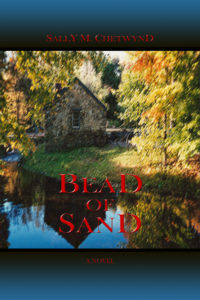A Personal History of Knitting
I’ve resumed regular knitting lately. My mother taught me to knit when I was four years old. My first project was a necktie for my father.
My father was an electrical engineer by trade. Every day he dressed in a suit and tie and went to work at General Electric’s meter department. He was a quiet, conservative man. (When my mother did something he didn’t like, he wouldn’t talk to her for three days. He was so close-mouthed that it took three days for her to notice that he hadn’t been talking to her and wonder what she’d done. But by that time, he had started talking to her again, so she never knew. This meant that most of the noise in our household was generated by us five rowdy children, all boys but one. Mother maintained that she never minded how much racket we kids made, as long as it was happy noise. If we quarreled, she’d separate us and send us to our rooms.)
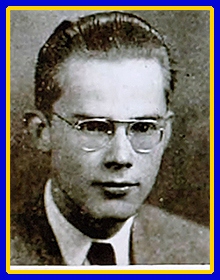 My father: Does this look like the kind of man
My father: Does this look like the kind of man
who would wear an orange necktie in public in the 1950s?
Back to the necktie: I selected bright orange yarn and began work, but it wasn’t long before I abandoned it. I hadn’t knitted enough yet for my fingers and hands to manage consistent tension – the tightness or looseness of the stitches. The more I knitted, the tighter the stitches got. It was only five or six inches long when I could no longer insert the needles into the stitches to create the next row.
I can’t say I was crestfallen. I imagine my father wasn’t, either. He had likely cringed at the idea of me completing the tie. If I had, he would have quietly put it on and gone to work, giving me pride that he was wearing my gift. But just as quietly, he would have slipped a more subtle tie into his pocket, to swap before going into his office, then do the reverse before coming home.
In college, my interest in knitting returned. Bicentennial reenactment activities captivated me. For my 1776-era uniform, I needed long, natural-fiber, over-the-knee stockings (practically impossible to find in 1975 in any commercial market) and a stocking cap with the word “LIBERTY” either knitted in or embroidered on it. I had learned to knit as a child; surely as an adult, I could remember how. I bought yarn and knitting needles and consulted a book about household crafts and fiber arts. All I needed to know were the two basic stitches – knit (K) and purl (P).
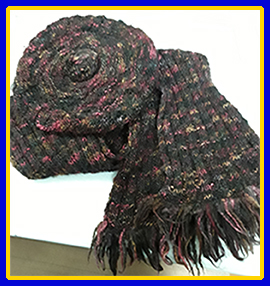 scarf ribbed with K2 P2 (2 knit stitches, then 2 purl stitches)
scarf ribbed with K2 P2 (2 knit stitches, then 2 purl stitches)
The Peruvian peasant woman who spun
this yarn labeled the dye lot “oil spill.”
I didn’t know about ribbing – alternating knit and purl stitches – which keeps the garment from rolling up on itself. It also provides tension (so your socks stay pulled up on your legs). My first cap was a failure – all knit stitches, so it curled up over my ears. I ribbed the first three inches of the next liberty cap, which did the trick, and ribbed a pair of long stockings next.
This newsletter is really about wool. I have done a small amount of knitting in cotton and an even smaller amount in synthetic yarn. Because I like wool and it likes me, and because of my reenactment activities in which natural fibers are encouraged, wool and I have become the best of friends. Lovely stuff!
To Tease Your Mind
Thou didst form my inward parts,
Thou didst knit me together in my mother’s womb.
I praise Thee because I am fearfully and wonderfully made.
 Psalm 139:13-14
Psalm 139:13-14
More About Wool
I love wool’s resilience, the springiness of a skein of yarn in the hand, its resistance to wet weather and its warmth even when wet, and its variety of textures. We get wool from several animals, most of which have different breeds providing different wools with different textures and qualities, each for a different purpose.
Besides sheep and lambs, we get wool from llamas, alpacas and their ilk, camels, goats (cashmere and mohair), rabbits (angora), bison and musk oxen, and long-haired breeds of both cats and dogs. All provide spinnable fibers. I have a Samoyed-doghair shawl made by a friend. Rabbit-hair spinners put the rabbit in their lap and spin yarn directly off it. (That’s got to feel really good to the rabbit!) It’s common to blend different kinds of animal fiber when spinning yarns.
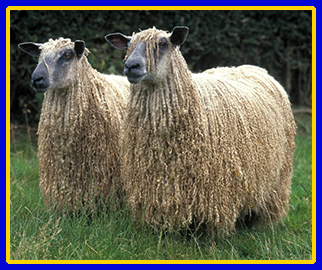
Wensleydale sheep with long-staple (long-fiber) wool
Spink & Co identifies seven qualities of sheep’s wool, which they incorporate in the manufacture of their mattresses. The wool they use differentiates their products from other brands.
- Fire resistant.
- Moisture wicking – because of the fiber’s “crimp” design
- Mildew and mold resistant – anti-microbial
- Hypoallergenic – against dust mites
- Flexible and durable
- Environmentally sustainable – neither husbandry nor harvest harms the animal or its environment
- Naturally insulating in both hot and cold climates
My mother discovered years ago that placing a woolen blanket underneath her bedsheet made her bed much warmer in the winter. I’ve done the same for years. I don’t bother to remove it in the summer, because of its insulating quality.
A lot of people are allergic to wool – it makes them itch; some suffer a rash. I count myself blessed not to suffer that malady, for I love wool. My mother couldn’t wear sheep’s wool next to her skin. Just seeing me cuddled up in a scratchy old Army blanket made her shudder. She could wear cashmere, however, a wool from certain breeds of goats. Cashmere is very fine, lightweight, and soft, and it’s three times warmer than sheep’s wool. Cashmere sweaters were ideal for her – she was a bitty thing and didn’t want the weight or bulk of heavy sweaters.
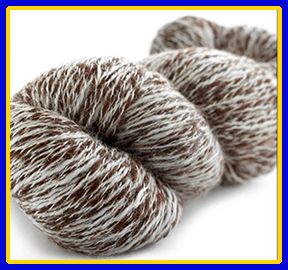
I tore apart an old cashmere sweater once and knitted her a pair of bed socks with it. Talk about luxurious! Bed socks they had to be, though – cashmere is too delicate to use as regular socks. A single day in a pair of shoes would wear them full of holes.
We adopted a dog named Snookie (he came with that name) from a local shelter in early 2006, a few months after we moved into our house. Highly intelligent (he never went on the wrong side of a pole!), he was also extremely discerning. When he discovered wool, he understood and appreciated it.
I have a woolen rug that my mother made using the shirret method. In the last three decades of her life, she made several dozen. Shirret rugs use the smallest scraps of woolen fabric, as small as one and a half inches long. No waste! Strips of wool are cut on the bias, three-quarters of an inch wide. They are folded, accordion-style or like ribbon candy, then bound through the middle of the folds using a crochet stitch with a special, long, hooked needle and a tough cotton cord. The rug never wears out because the edges of those bias strips are raw. It’s also reversible. Shirret rugs can be made round, oblong, or rectangular.
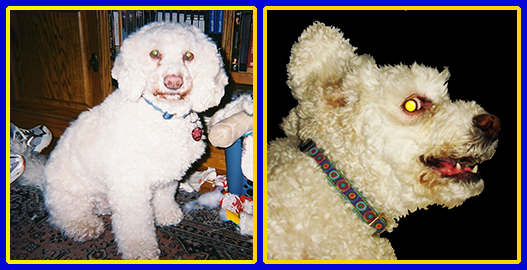 LEFT: How we in Snookie’s pack saw him. (Cute, hunh?)
LEFT: How we in Snookie’s pack saw him. (Cute, hunh?)
RIGHT: How anyone NOT in Snookie’s pack saw him. (Demented demon dog!)
Snookie spent his first days with us exploring the house. One day he explored the room with that rug. He sauntered in and sniffed around. When he stepped on the rug, he stopped, backed up, sniffed it, then placed his front paws on it to test its springiness. He walked around on it for some time, inspecting it in detail, sniffing and pushing at it with his nose. (He used his nose a lot to test the mass and texture of objects.) I swear he was smiling by the time he left the room.
Before I was married, I made a queen-size quilt from 6”x6” squares of wool left over from my sewing projects. One piece of wool was thinner than most, and 30+ years later, those squares were thread-bare. The solution was to cut them out and insert new squares, appliquéing them in by hand. Over two dozen squares needed replacing, so it took time, but a good project to work on while watching TV.
When Snookie discovered this woolen quilt, he staked his claim on it. I’d be in the comfy chair, the quilt piled on my lap, hand-stitching a new square pinned into place. I soon recognized his look when he was about to jump up on me – it was no use to try to discourage him – so I could pull the pinned section up out of his way so he wouldn’t get pins in his paws. Then he’d settle down on it and get cozy. Getting him to move when I had to get up was another challenge. How dare I disturb him!
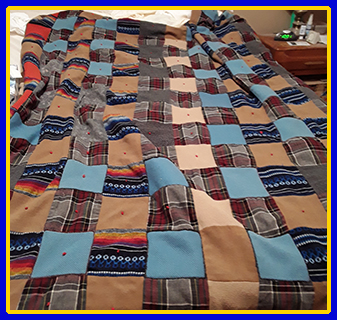 The solid blue ones are the newer replacements.
The solid blue ones are the newer replacements.
The plain gray squares on the upper-left need replacing now.
With its repairs finished, I lugged it out to the car to take to the drycleaner. Snookie followed me, eyeing me anxiously. What was I doing with his quilt?! He was dismayed when it came back and was installed on our bed in a room with a closed door at night.
Fisherman’s knit sweaters were all the rage when I was in college, so shortly after graduating, I decided to make one for myself. Still not being a proficient knitter, I decided on a very simple pattern – natural-white yarn for the body, with natural-grayish-brown for the cuffs and collar, which wouldn’t show the dirt. I opted for a diamond pattern in the body and on the sleeves, making a single purl stitch at intervals. The front and back were identical. I got this idea from a college-mate, who knitted such sweaters and wore them four ways: When the front got dirty, he put it on backward; when that side got dirty, he turned it inside out and repeated. (I’ve never gone that far; I wash mine once every year or two.)
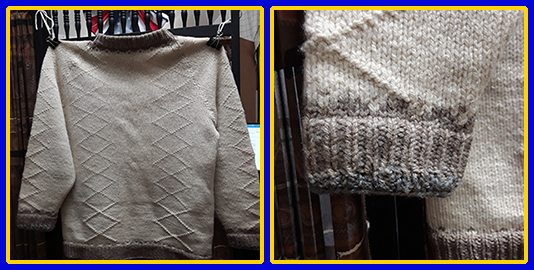 LEFT: my heavy fisherman’s knit woolen sweater
LEFT: my heavy fisherman’s knit woolen sweater
RIGHT: detail of the repaired cuff (new yarn – gray – doesn’t quite match)
I used #2 needles (very small!) with the heavy, fisherman’s knit yarn (with its natural lanolin). Most knitters would consider this insane. Maybe it was. But I tell you, nothing goes through that sweater! It’s a working sweater. I wear it for outside work in the yard and shoveling snow. Most dirt on it brushes off when dry. Last winter (40+ years later) I re-knitted the last row on the ends of the cuffs, which had worn out, but the rest of it is just as tough as when it was new.
Update On My Own Writing
Work on my short-story-turned-novella-turned-book about Nicodemus progresses steadily. I’m still having a blast researching every aspect of life in Israel in Jesus’s times. (See my notes on the history of bread, below. Some other time I’ll report on another volume I’m reading – A History of Dams. Yes, I’m geeky.) Poor Nicodemus! Right now he’s having a tough time sorting fact from fiction from fantasy during the trial of Jesus before the Jewish council. The plot thickens!
A Book Worth Checking Out
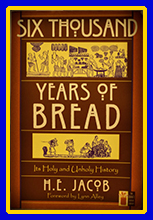 Six Thousand Years of Bread: Its Holy and Unholy History (1944)
Six Thousand Years of Bread: Its Holy and Unholy History (1944)
H. E. Jacob
“Yeast, water, flour, and heat. How could this simple mixture have been the ccause of war and plague, celebration and victory, supernatural vision and more? In this remarkable and all-encompassing volume, H. E. Jacob takes us through six thousand dynamic years of bread’s role in politics, religion, technology, and beyond. Who were the first bakers? Why were bakers distrusted during the Middle Ages? How did bread cause Napoleon’s defeat? Why were people buried with bread? Six Thousand Years of Bread has the answers.
“Jacob follows the story from its beginning in ancient Egypt and continues through to modern times. The poignant and inspiring conclusion of the book relays the author’s experiences in a Nazi concentration camp, subsisting on bread made of sawdust.”
After surviving a Nazi concentration camp, Jacob no doubt really understood how to appreciate good bread.
I ordered this book for research on my Nicodemus story. I came across it about 45 years ago in a library. It was so fascinating that I’ve never forgotten it. It traces the cultural, ethnic, religious, political, and economic facets of bread, from pre-Exodus Egypt (where the Egyptians introduced the Jews to leavened bread and the use of ovens to bake it) to Israel, then the influence of Greece and Rome. It travels through the Middle Ages into the early Americas, into the 19th Century, and into modern times.
It’ll be great fun making friends again with this narrative. Any avid baker would enjoy it, too.
Calendar & Announcements
Sunday, February 26, 2023 – Authors at the Vineyard
Zorvino Vineyards, 226 Main Street, Sandown, NH 03873
11 am – 4 pm
FREE to the public
16 local authors participating (including Yours Truly)
- come and meet local authors
- talk with them about your favorite genres
- discover new titles
- replenish your winter reading list
- support your local wordsmiths
Organized by New England Author Expo https://newenglandauthorsexpo.com/
Sources
Image: Smart History – virgin & child (Byzantine mosaic)
https://smarthistory.org/picturing-salvation/
Image: Wensleydale sheep
https://little-barn.myshopify.com/products/wensleydale
Image: Peruvian alpaca tweed yarn
https://www.ceceswool.com/new-england-fiber-festival/peruvian-alpaca-tweed-yarn/



